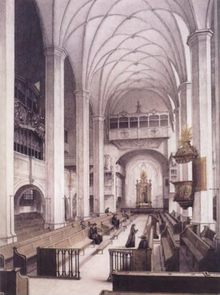BWV 95
|
Christus, der ist mein Leben BWV 95 |
|
|---|---|
| Church cantata by J. S. Bach | |

Thomaskirche, Leipzig
|
|
| Occasion | 16th Sunday after Trinity |
| Performed | 12 September 1723: Leipzig |
| Movements | 7 |
| Cantata text | anonymous |
| Chorale |
|
| Vocal | |
| Instrumental |
|
Christus, der ist mein Leben (Christ, he is my life),BWV 95, is a church cantata by Johann Sebastian Bach. He composed it in Leipzig for the 16th Sunday after Trinity and first performed it on 12 September 1723.
Bach wrote the cantata in his first year Bach in Leipzig for the 16th Sunday after Trinity and first performed it on 12 September 1723. The prescribed readings for the Sunday were from the Epistle to the Ephesians, praying for the strengthening of faith in the congregation of Ephesus (), and from the Gospel of Luke, the raising from the dead of the Young man from Nain (). In Bach's time the story pointed immediately at the resurrection of the dead, expressed as a desire to die soon. As Salomon Franck expressed in his text for cantata Komm, du süße Todesstunde, BWV 161, composed in Weimar in 1715, the unknown poet concentrates on a desire to die, in hope to be raised like the young man from Nain. The poet includes four stanzas from four different chorales. Two stanzas from chorales are already presented in the first movement, "Christus, der ist mein Leben" (Jena 1609) and Martin Luther's "Mit Fried und Freud ich fahr dahin" (1524), a paraphrase of the canticle Nunc dimittis. Movement 3 is Valerius Herberger's "Valet will ich dir geben", and the closing chorale is the fourth stanza of Nikolaus Herman's "Wenn mein Stündlein vorhanden ist".
...
Wikipedia
